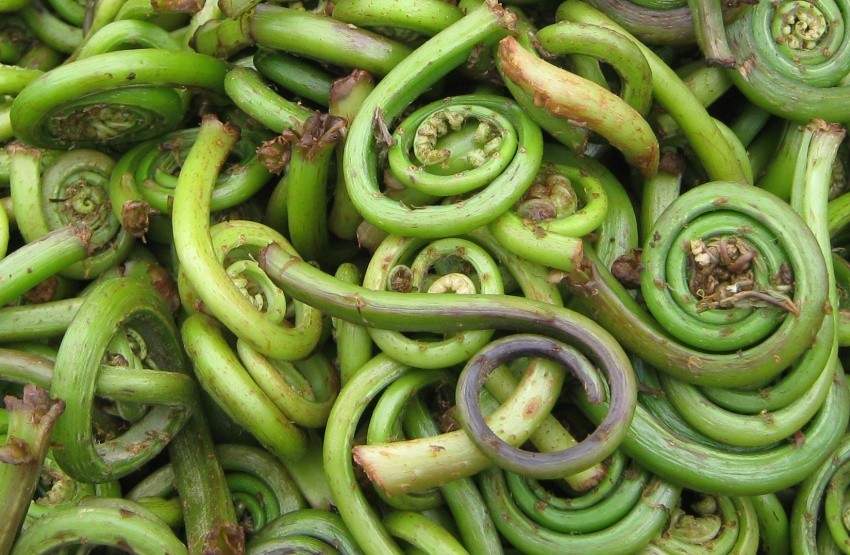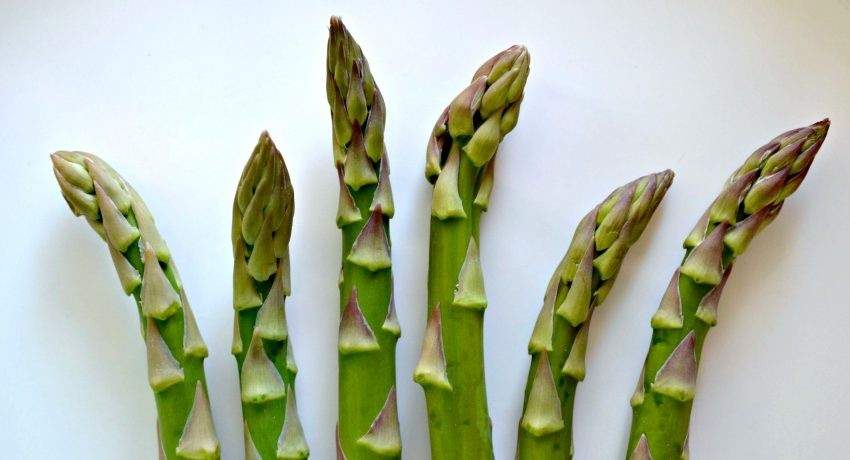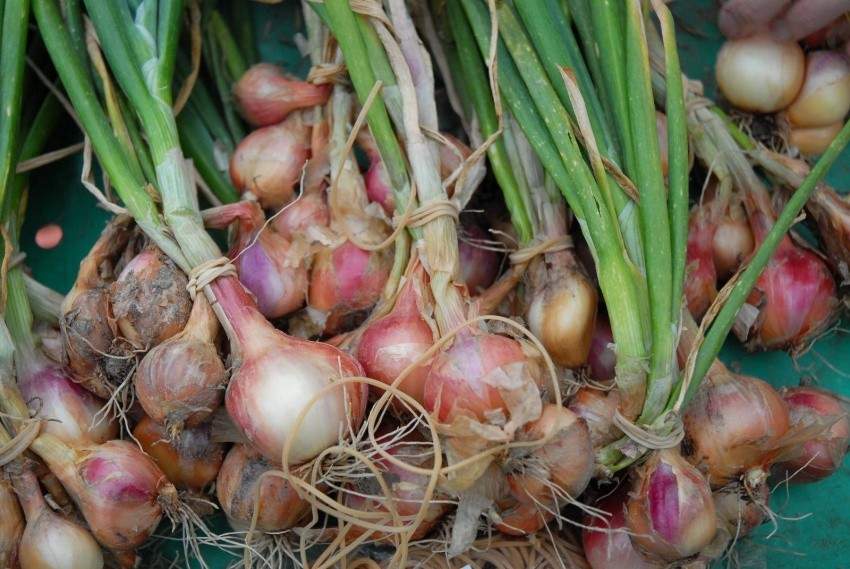Winter in Canada doesn’t exactly lend itself to producing a variety of fruits and vegetables. Come springtime, anything at the farmers’ market that isn’t related to a cabbage, beet, or potato is a welcomed sight. To help get you inspired from the colourful bounty of spring, we’ve compiled our favourite spring produce, and tips on what to do with it.
Ramps
Despite the name, these have nothing to do with accessibility features. Rather, they’re a wild version of leeks or onions, and have a flavour that tastes as such, with a hint of garlic thrown into the mix. Similar to green onions, both the green leafy ends and white roots are edible. Ramps can be grilled or sautéed and eaten as is, or incorporated into other recipes like pesto. Try a Canadian version of Asian scallion pancakes by subbing in ramps instead!
Fiddleheads

Fiddleheads are the immature growth of the ostrich fern. They are harvested wild for a short two- to three-week period in May (sometimes earlier, depending on the location, as fiddleheads can be found across B.C., ON, and the Maritimes), so you have to get ‘em while they last. Look for tightly wrapped and bright green fiddleheads. Browning is a sign of oxidation, which indicates that they are less fresh. They have a grassy taste similar to asparagus, and come packed with health benefits, containing two times the amount of antioxidants found in blueberries. Simply blanched and cooked off in a pan of brown butter, they’re a real treat, but given their limited availability, try pickling or freezing them for later use.
photo courtesy of Glenn Fleishman via Flickr.
Rhubarb
Nothing brings me back to my childhood like a big dish of rhubarb crisp. Rhubarb isn’t for everyone, but if you love all things tart, look for this vegetable (yes, it’s a vegetable, not a fruit) from now until the end of June or so. Thinner stalks tend to be less tough and fibrous than their thicker counterparts. And, remember that the leaves are poisonous, so you can just toss them right into the bin. Rhubarb is typically used in homey desserts (think crisps, crumbles, and pies), but you can also kick things up a notch with rhubarb tarts, upside down cakes, or by poaching and layering it into the classic British dessert, Eton Mess. Don't exclude it from your savoury cooking either. Add a bit of it into a beet salad or stewing it down with chicken or pork.
Asparagus

Although asparagus is available year round from different part of the world. nothing beats the local stuff that is available come May or June. It’s incredible how much more palatable it is coming from local soil, compared to when it is shipped across continents. Go figure! Look for spears that are firm and snappy. The tips should be fresh and compact, not wilted or mushy. Also, when preparing them, there’s the tendency to cut off and discard more of the ends than necessary. When asparagus is thin and tender, the majority of the stalks are edible. Don’t forget to reserve the ends you’ve cut off for stocks or sauces, say, for asparagus soup? Although it almost sounds too simple, you really can’t go wrong with just grilling asparagus with a light drizzling of oil until gently charred, or sprinkling of flake salt, fresh cracked black pepper, and a squeeze of lemon, and eat.
Artichokes
Artichokes are mostly grown in California, which really isn’t that far away from Western Canada, but you can also find ones produced in Ontario toward the end of spring or beginning of summer. I won’t sugar coat it: artichokes are notorious for being nit-picky to prepare and clean, but given that artichoke season only comes around once a year, the extra work is worth it. Look for baby artichokes if they are available, as they are more tender and less of the fibrous outer leaves require removing. Also, don’t forget to hold them in acidulated water to prevent oxidization, and be sure to scrape off the prickly choke from the centre to avoid any unintentional “choking” hazards. When artichokes are at their peak, I say they're best served steamed with a generous side of Hollandaise for dipping. However, if you are looking to get more creative, try making artichoke kimchi, or the hearts en confit in olive oil to serve as a side for steak.
Spring onions

Not to be confused with scallions or green onions, spring onions have a bulb at the bottom, and as their name suggests, are harvested during spring. The actual onion bulb is milder than a regular onion, but the greens are stronger than green onions or scallions, so take that into consideration when making substitutions. Because spring onion bulbs are so mild, they are the ideal onion to consume raw, either straight up or lightly pickled and served atop a big, green salad. Add spring onions into quiche in place of leeks. Or, try coating them in tempura batter and fry until light and crispy; spring onions would make a lovely addition to a fritto misto platter.
photo courtesy of Cultivate Oxford via Flickr.
Morels
Mushroom lovers rejoice! Spring is here and it’s time for morels! These wild beauties are foraged in British Columbia and the Northwest Territories during May and June, after which you can find them dried throughout the year. Because of all of their sponge-like nooks and crannies, you want to be especially thorough when cleaning morels to make sure you get all of the grit out. Unlike other mushrooms, you need to wash them prior to eating, lest you end up with a mouthful of sand, and no one wants that. I’m a mushroom purest myself, so nothing makes me happier than the thought of fresh morels sautéed in butter or good-quality canola oil. That being said, they also pair beautifully with green spring vegetables like fava beans or peas. Toss that mixture with some homemade pasta or gnocchi, and you’ll never want to eat anything else.
Stinging nettles
I know, I know, there’s definitely a tendency to shy away from ingredients that have the potential to harm or injure us, but when properly prepared, there’s no reason not to include stinging nettles in your spring produce repertoire (or you can do as they do at the World Nettle Eating Championship in the UK and see how much of the stuff you can consume raw, although I wouldn’t recommend it). Stinging nettles are found across Canada and have a long history of being used for medicinal purposes. Only more recently have they been toted for their culinary potential, with their greens that taste like chard or spinach. So how do you get around the whole “stinging” thing? Wear gloves to protect your hands while you wash and rinse them. Once you cook them, their stinging power goes away. Try making a puree of cooked nettles into polenta or risotto, or add dairy and eat it as a pseudo creamed spinach. Nettle soup is also a popular option, and you really can’t beat the vibrant green colour.
Radishes
Radishes are one of the cheapest, most underused vegetables out there. Seen by many as being exclusive to raw applications like crudité platters, their potential when cooked is endless. Roasting or sautéing radishes until tender helps to mellow out their pepperiness, making them much more palatable to some. There are also many different varieties to choose from. The bright red cherry belle is most common, but more and more often, you see others, like French breakfast, white icicle, and baby daikon. Stock up between now and summer, and experiment! Homemade pickled radishes, complete with a zippy radish puree, to garnish falafel, perhaps?
Fava beans
Time to get shucking! Yes, fava beans are a pain in the butt to prep. Not only do you have to shuck the beans out of their pods, but you have to remove the skin around each bean. The easiest way to accomplish this is to blanch the shucked beans for about 30 seconds and then shock them in ice water. The skin should slip right off. Mash them on toast for a light lunch (think hummus but much greener!), or make a succotash with whatever other fresh veg you have on hand. If you’re feeling energetic, you can shuck a big bunch of favas and freeze them, for a taste of spring throughout the year.













